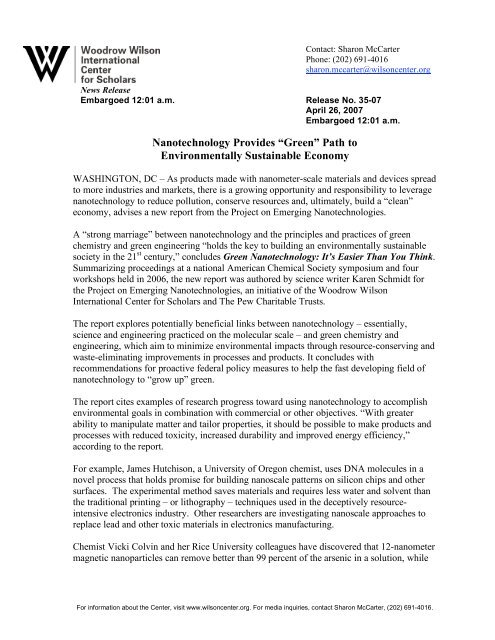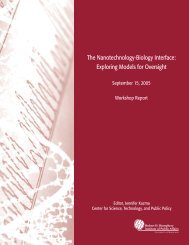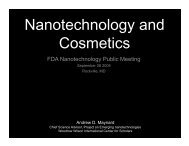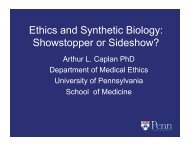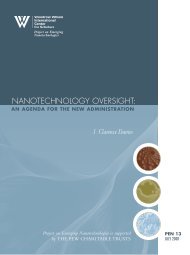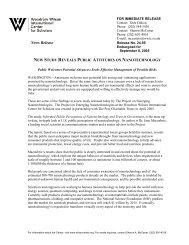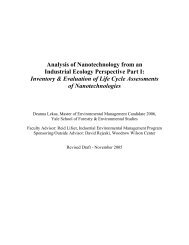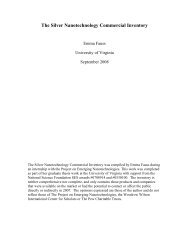Nanotechnology Provides “Green” - Project on Emerging ...
Nanotechnology Provides “Green” - Project on Emerging ...
Nanotechnology Provides “Green” - Project on Emerging ...
Create successful ePaper yourself
Turn your PDF publications into a flip-book with our unique Google optimized e-Paper software.
-------------------------------- C<strong>on</strong>tact: Shar<strong>on</strong> McCarter<br />
Ph<strong>on</strong>e: (202) 691-4016<br />
shar<strong>on</strong>.mccarter@wils<strong>on</strong>center.org<br />
News Release<br />
Embargoed 12:01 a.m. Release No. 35-07<br />
April 26, 2007<br />
Embargoed 12:01 a.m.<br />
<str<strong>on</strong>g>Nanotechnology</str<strong>on</strong>g> <str<strong>on</strong>g>Provides</str<strong>on</strong>g> <str<strong>on</strong>g>“Green”</str<strong>on</strong>g> Path to<br />
Envir<strong>on</strong>mentally Sustainable Ec<strong>on</strong>omy<br />
WASHINGTON, DC – As products made with nanometer-scale materials and devices spread<br />
to more industries and markets, there is a growing opportunity and resp<strong>on</strong>sibility to leverage<br />
nanotechnology to reduce polluti<strong>on</strong>, c<strong>on</strong>serve resources and, ultimately, build a “clean”<br />
ec<strong>on</strong>omy, advises a new report from the <str<strong>on</strong>g>Project</str<strong>on</strong>g> <strong>on</strong> <strong>Emerging</strong> Nanotechnologies.<br />
A “str<strong>on</strong>g marriage” between nanotechnology and the principles and practices of green<br />
chemistry and green engineering “holds the key to building an envir<strong>on</strong>mentally sustainable<br />
society in the 21 st century,” c<strong>on</strong>cludes Green <str<strong>on</strong>g>Nanotechnology</str<strong>on</strong>g>: It’s Easier Than You Think.<br />
Summarizing proceedings at a nati<strong>on</strong>al American Chemical Society symposium and four<br />
workshops held in 2006, the new report was authored by science writer Karen Schmidt for<br />
the <str<strong>on</strong>g>Project</str<strong>on</strong>g> <strong>on</strong> <strong>Emerging</strong> Nanotechnologies, an initiative of the Woodrow Wils<strong>on</strong><br />
Internati<strong>on</strong>al Center for Scholars and The Pew Charitable Trusts.<br />
The report explores potentially beneficial links between nanotechnology – essentially,<br />
science and engineering practiced <strong>on</strong> the molecular scale – and green chemistry and<br />
engineering, which aim to minimize envir<strong>on</strong>mental impacts through resource-c<strong>on</strong>serving and<br />
waste-eliminating improvements in processes and products. It c<strong>on</strong>cludes with<br />
recommendati<strong>on</strong>s for proactive federal policy measures to help the fast developing field of<br />
nanotechnology to “grow up” green.<br />
The report cites examples of research progress toward using nanotechnology to accomplish<br />
envir<strong>on</strong>mental goals in combinati<strong>on</strong> with commercial or other objectives. “With greater<br />
ability to manipulate matter and tailor properties, it should be possible to make products and<br />
processes with reduced toxicity, increased durability and improved energy efficiency,”<br />
according to the report.<br />
For example, James Hutchis<strong>on</strong>, a University of Oreg<strong>on</strong> chemist, uses DNA molecules in a<br />
novel process that holds promise for building nanoscale patterns <strong>on</strong> silic<strong>on</strong> chips and other<br />
surfaces. The experimental method saves materials and requires less water and solvent than<br />
the traditi<strong>on</strong>al printing – or lithography – techniques used in the deceptively resourceintensive<br />
electr<strong>on</strong>ics industry. Other researchers are investigating nanoscale approaches to<br />
replace lead and other toxic materials in electr<strong>on</strong>ics manufacturing.<br />
Chemist Vicki Colvin and her Rice University colleagues have discovered that 12-nanometer<br />
magnetic nanoparticles can remove better than 99 percent of the arsenic in a soluti<strong>on</strong>, while<br />
For informati<strong>on</strong> about the Center, visit www.wils<strong>on</strong>center.org. For media inquiries, c<strong>on</strong>tact Shar<strong>on</strong> McCarter, (202) 691-4016.
their counterparts at Oklahoma State University have engineered nanoscale sensors that can<br />
detect pollutants at the level of parts per billi<strong>on</strong>.<br />
<str<strong>on</strong>g>Nanotechnology</str<strong>on</strong>g> has opened promising new routes for making inexpensive solar cells as well<br />
as improving the performance and lowering the cost of fuel cells, eyed as the energy source<br />
for cars and trucks of the future. At the same time, work at the nanoscale is leading toward<br />
tools for removing toxic materials and cleaning up hazardous waste sites.<br />
“<str<strong>on</strong>g>Nanotechnology</str<strong>on</strong>g> potentially is a ‘doubly green dream.’ It offers us the opportunity to make<br />
products and processes ‘green’ from the beginning,” explained Barbara Karn, an<br />
envir<strong>on</strong>mental scientist who helped organize the green nanotechnology programs while with<br />
the <str<strong>on</strong>g>Project</str<strong>on</strong>g> <strong>on</strong> <strong>Emerging</strong> Nanotechnologies. “It also allows us to substitute more<br />
envir<strong>on</strong>mentally-friendly chemicals, materials and manufacturing processes for older, more<br />
polluting <strong>on</strong>es.”<br />
The report defines four categories in which nanotechnology applicati<strong>on</strong>s and envir<strong>on</strong>mental<br />
interests intersect:<br />
• Fostering new nanotechnology-enabled products and processes that are<br />
envir<strong>on</strong>mentally benign – or “clean and green”;<br />
• Managing nanomaterials and their producti<strong>on</strong> to minimize potential<br />
envir<strong>on</strong>mental, health, and safety risks;<br />
• Using nanotechnology to clean up toxic waste site and other legacy polluti<strong>on</strong><br />
problems; and<br />
• Substituting green nanotechnology products for existing products that are less<br />
envir<strong>on</strong>mentally friendly.<br />
“We think the United States is <strong>on</strong> track to be a global leader in green nanotech,” said David<br />
Rejeski, director of the <str<strong>on</strong>g>Project</str<strong>on</strong>g> <strong>on</strong> <strong>Emerging</strong> Nanotechnologies. “The country’s research and<br />
development portfolio should be directed toward this goal. We believe green nanotechnology<br />
can not <strong>on</strong>ly help protect the envir<strong>on</strong>ment but also be a source of American jobs and<br />
company profits in the future.”<br />
Looking ahead, bey<strong>on</strong>d legacy envir<strong>on</strong>mental problems of today, the report suggests that the<br />
most effective approach to protecting the envir<strong>on</strong>ment would be to “develop green nano<br />
policies that actively promote polluti<strong>on</strong> preventi<strong>on</strong>.”<br />
Ranging from developing metrics for evaluating bottom-line envir<strong>on</strong>mental impacts to using<br />
federal procurement to foster demand for green nanoproducts, the recommended policy steps<br />
outlined in the report would help to ensure that the $8.3 billi<strong>on</strong> taxpayer investment in<br />
nanotechnology, since the U.S. Nati<strong>on</strong>al <str<strong>on</strong>g>Nanotechnology</str<strong>on</strong>g> Initiative was established in 2001,<br />
pays off for the country and the envir<strong>on</strong>ment.<br />
“We are <strong>on</strong> an unsustainable path,” said Paul Anastas, director of the American Chemical<br />
Society’s Green Chemistry Institute. “It is not as though nanotechnology will be an opti<strong>on</strong>; it<br />
is going to be essential for coming up with sustainable technologies.”<br />
About <str<strong>on</strong>g>Nanotechnology</str<strong>on</strong>g><br />
For informati<strong>on</strong> about the Center, visit www.wils<strong>on</strong>center.org. For media inquiries, c<strong>on</strong>tact Shar<strong>on</strong> McCarter, (202) 691-4016.
<str<strong>on</strong>g>Nanotechnology</str<strong>on</strong>g> is the ability to measure, see, manipulate and manufacture things usually<br />
between 1 and 100 nanometers. A nanometer is <strong>on</strong>e billi<strong>on</strong>th of a meter; a human hair is<br />
roughly 100,000 nanometers wide. More than $30 billi<strong>on</strong> in products incorporating<br />
nanotechnology were sold globally in 2005. By 2014, Lux Research estimates this figure will<br />
grow to $2.6 trilli<strong>on</strong>.<br />
The <str<strong>on</strong>g>Project</str<strong>on</strong>g> <strong>on</strong> <strong>Emerging</strong> Nanotechnologies is an initiative launched by the Woodrow<br />
Wils<strong>on</strong> Internati<strong>on</strong>al Center for Scholars and The Pew Charitable Trusts in 2005. It is<br />
dedicated to helping business, government and the public anticipate and manage possible<br />
health and envir<strong>on</strong>mental implicati<strong>on</strong>s of nanotechnology. For more informati<strong>on</strong> about the<br />
project, log <strong>on</strong> to www.nanotechproject.org.<br />
The Pew Charitable Trusts (www.pewtrusts.org) is driven by the power of knowledge to<br />
solve today’s most challenging problems. Pew applies a rigorous, analytical approach to<br />
improve public policy, inform the public and stimulate civic life. We partner with a diverse<br />
range of d<strong>on</strong>ors, public and private organizati<strong>on</strong>s and c<strong>on</strong>cerned citizens who share our<br />
commitment to fact-based soluti<strong>on</strong>s and goal-driven investments to improve society.<br />
The Woodrow Wils<strong>on</strong> Internati<strong>on</strong>al Center for Scholars is the living, nati<strong>on</strong>al memorial<br />
to President Wils<strong>on</strong> established by C<strong>on</strong>gress in 1968 and headquartered in Washingt<strong>on</strong>, D.C.<br />
The Center establishes and maintains a neutral forum for free, open, and informed dialogue.<br />
It is a n<strong>on</strong>partisan instituti<strong>on</strong>, supported by public and private funds and engaged in the study<br />
of nati<strong>on</strong>al and internati<strong>on</strong>al affairs.<br />
###<br />
For informati<strong>on</strong> about the Center, visit www.wils<strong>on</strong>center.org. For media inquiries, c<strong>on</strong>tact Shar<strong>on</strong> McCarter, (202) 691-4016.


